#anishinaabemowin
Text
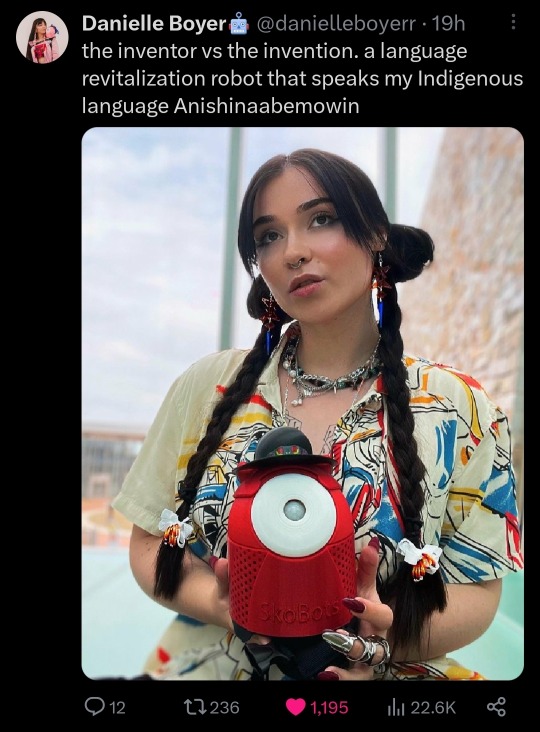
Alt: the inventor vs the invention. a language revitalization robot that speaks my Indigenous language Anishinaabemowin pic.twitter.com/ydo88kMzT9
Photo of inventor Daniel Boyer holding language bot. Hair in large buns with braids going down and wearing cream shirt with colorful abstract design on it.
— Danielle Boyer🤖 (@danielleboyerr) February 1, 2024
#Danielle Boyer#Inventors#Engineers#Language#Robots#Anishinaabemowin#Indigenous#Indigenous people in tech#Tech#Technology#Alt text in image#Image description in image
6K notes
·
View notes
Note
I’ve seen Palestinians refer to their homeland as Occupied Palestine and “Israel” as the occupation, to better illustrate the settler colonial history of “Israel” and deny it legitimacy. As “America” is also a settler colony, would it be accurate to refer to the so-called “USA” in general as Occupied Turtle Island/the American Occupation or is that terminology specific to Palestine?
Turtle Island is the name given to North America by the Anishinaabe, though it's certainly not the only indigenous name. The Anishinaabe/Ojibwe/Chippewa just happen to be one of the largest native group so a lot of our terms are more easily popularized.
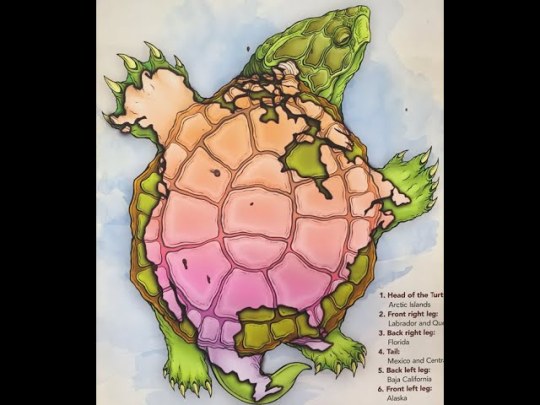
And I'd say yes and no as for it's accuracy tbh.
Like with Palestine, you have to be Very Clear when differentiating the people of Turtle Island and our wants from the US government and the people who support the US government.
You can't support Palestinian liberation and the existence of the state colonizing them. In the same way you can't claim to support Native liberation and Turtle Island but still want to remain our colonizer.
It's one thing to say you support native sovereignty, it's another entirely to realize that support in practice would mean calling & working for the US to be dismantled; it means Choosing to be a person from Turtle Island instead.
So yes, call it Turtle Island, but say it with the understanding and gravity of it.
Start by learning 5 medicinal plants and 5 edible plants in your area, figure out how you can support local tribes. Learn how to be from Turtle Island instead of the USA. Find values and principles to believe in that are your own and not just moralized propaganda.
The less dependent you are on the US, the less freedom you realize you have within it.
#asked#answered#turtle island#settler colonialism#colonization#decolonization#Decolonize#ojibwe#chippewa#Anishinaabe#anishinaabemowin#first nations#native american#ndn
818 notes
·
View notes
Photo

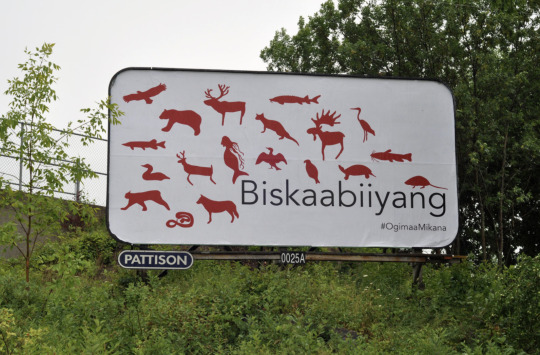


Ogimaa Mikana. Don’t be shy to speak Anishinaabemowin when it’s time. Bayfield St., Barrie, Ontario; Biskaabiiyang. North Bay, Ontario; Untitled (All Walls Crumble). Ottawa, Ontario; Anishinaabe manoomin inaakonigewin gosha. Peterborough, Ontario.
Ogimaa Mikana is an artist collective founded by Susan Blight (Anishinaabe, Couchiching) and Hayden King (Anishinaabe, Gchi’mnissing) in January 2013. Through public art, site-specific intervention, and social practice, we assert Anishinaabe self-determination on the land and in the public sphere.
The Ogimaa Mikana Project is an effort to restore Anishinaabemowin place-names to the streets, avenues, roads, paths, and trails of Gichi Kiiwenging (Toronto) - transforming a landscape that often obscures or makes invisible the presence of Indigenous peoples. Starting with a small section of Queen St., re-naming it Ogimaa Mikana (Leader's Trail) in tribute to all the strong women leaders of the Idle No More movement, the project hopes to expand throughout downtown and beyond.
“The Anishinaabeg endure. We do so through settler colonial time, and across space. We do so in contention. Untitled (All Walls Crumble) considers this movement. To be Indigenous in the city is so often a struggle for recognition, to be seen, and to resist the erasure that is common in Toronto, Montreal, Ottawa, etc. Yet with recognition also comes appropriation and co-optation. In this unease, we consider the benefits of erasure, or at least, covert movement.
Inspired by stories of our relatives and ancestors counting coup, and Basil Johnson’s description of warfare more generally, the Ogimaa Mikana Project considers the tension between visibility and invisibility to challenge settler colonial logic. Against a crumbling wall holding up Ottawa’s major highway - scheduled for demolition and replacement - we draw attention to the ways the settler state recycles itself, and by extension, affirms its legitimacy. We see it and resist in provocative ways that mirror a there/not there presence.
Against this crumbling wall, we reclaim space for an anti-recognition: to speak to each other, as Anishinaabeg, as communities pushed out by gentrification, as the colonized, and offer a refrain and a sign of defiance: “Wakayakoniganag da pangishin. Nin d'akiminan kagige oga ahindanize.”
#Ogimaa Mikana#susan blight#Hayden King#anishinaabeg#anishinaabe#Anishinaabe artist#anishinaabeg artists#Anishinaabe Art#indigenous art#INDIGENOUS CONTEMPORARY ART#contemporary art#public art#place-naming#intervention#art intervention#contemporary anishinaabe art#indigenous collective#indigenous artist collective#Anishinaabemowin
855 notes
·
View notes
Text
the word for insects (worms and germs) in Ojibwe is “manitoosh” which literally translates to “tiny cute spirit”.
I think this is amazing and also beautiful
#orb pondering#wizard#wizard orb#wizard pondering his orb#wizard posting#wizardcore#wizardposting#pondering my orb#botany#ojibwe#anishinaabe#Anishinaabemowin#entomology#insects
1K notes
·
View notes
Text
Fun fact: in Anishinaabemowin, the term for a cat purring is "nagamo gaazhagehns" / "nagamo biizhehns" / " nagamo boozhehns" (different dialects have varying words/spellings for a house cat)
But the main thing is that "nagamo" is the verb for "he/she/that one sings"
Cat purring in Anishinaabemowin is essentially called "cat singing"
#anishinaabemowin#ojibwemowin#ojibwe#anishinaabe#indigenous languages#the words for cat also are fun#gaazhagehns comes from the verb 'gaazhage' which means 'he/she/that one eats greedily or is gluttonous#so gaazhagehns translates roughly to 'little greedy eating one'#and boozhehns/biizhehns are the diminutive versions of the the word for a lynx (bizhiw) because#--that was the example of a feline that existed in our language/world when domestic cats were introduced to us#so we just called them 'tiny/baby lynxes'#i love anishinaabemowins maliability and ability to just create words to address new things#nish tag#linguistics#original posts#indigenous tag
226 notes
·
View notes
Text
Milestone Monday
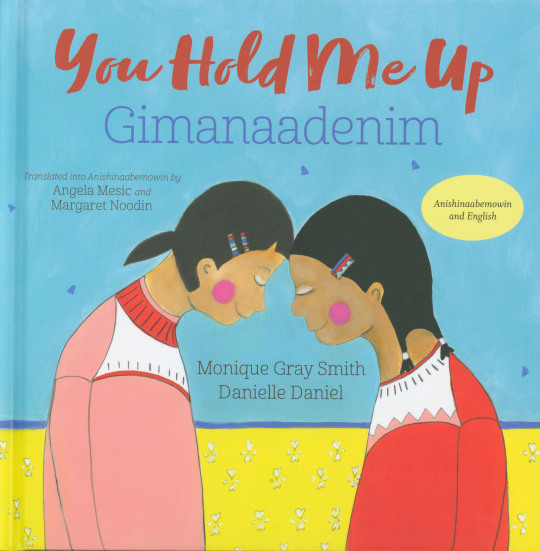
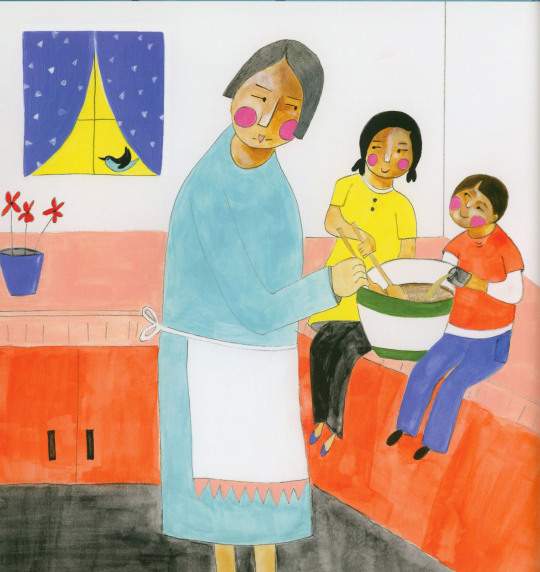

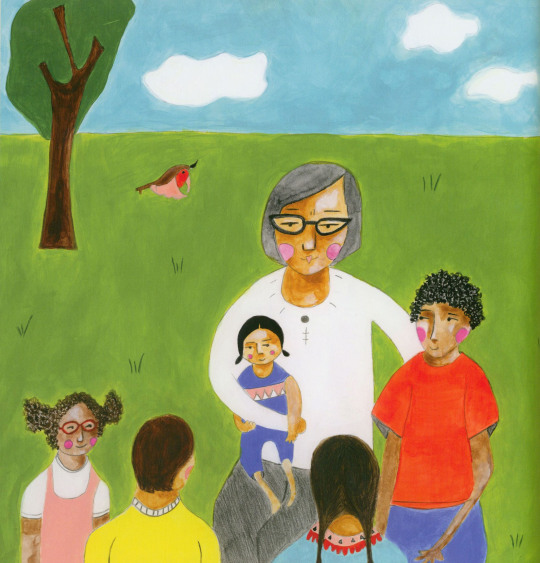
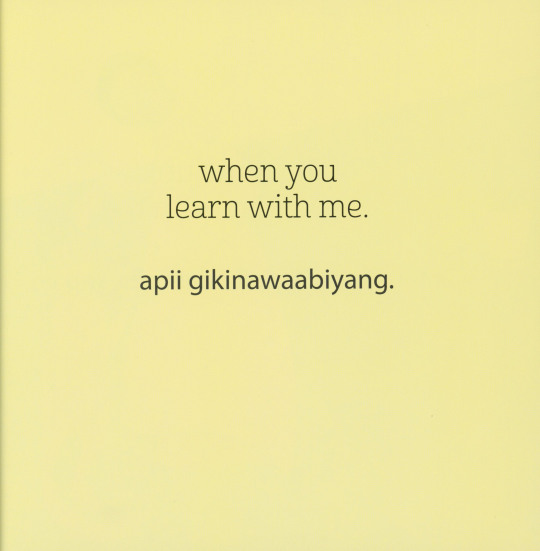
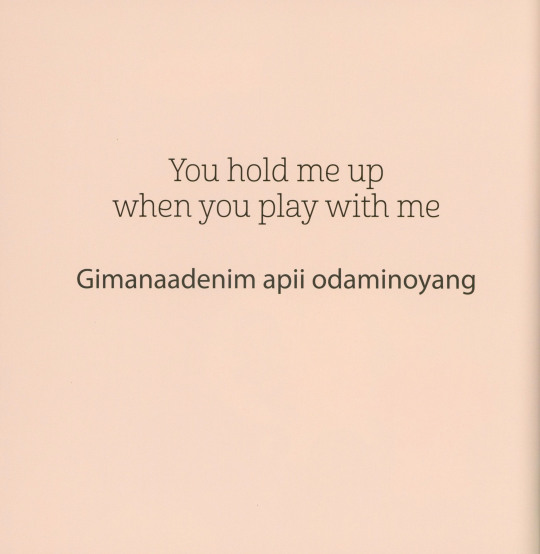

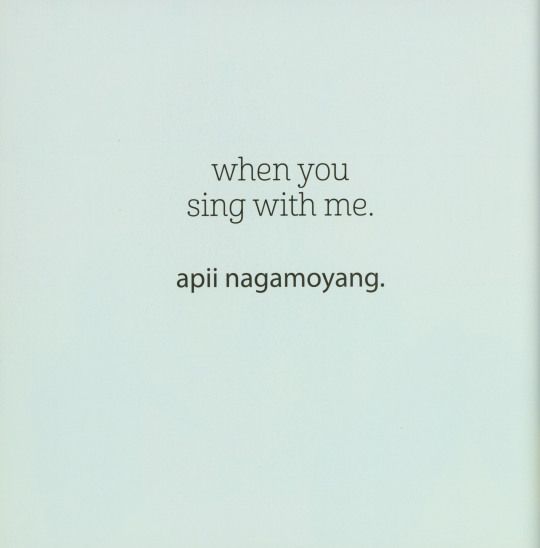
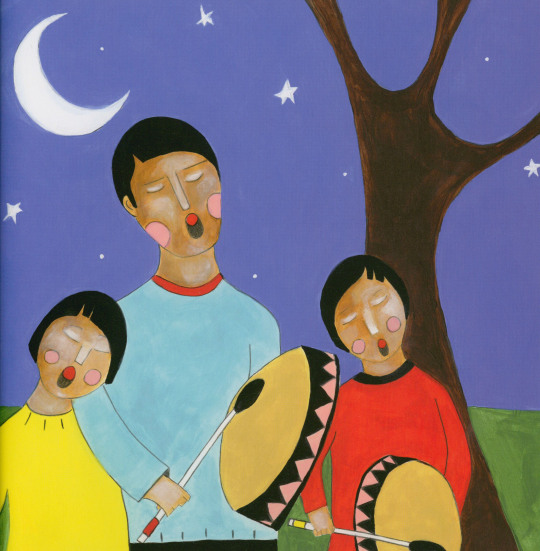




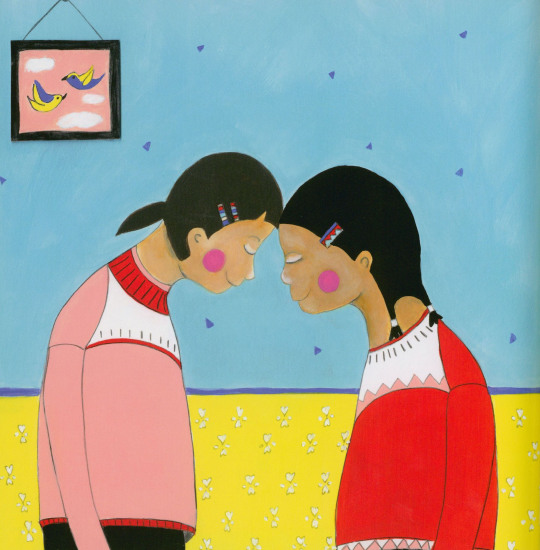
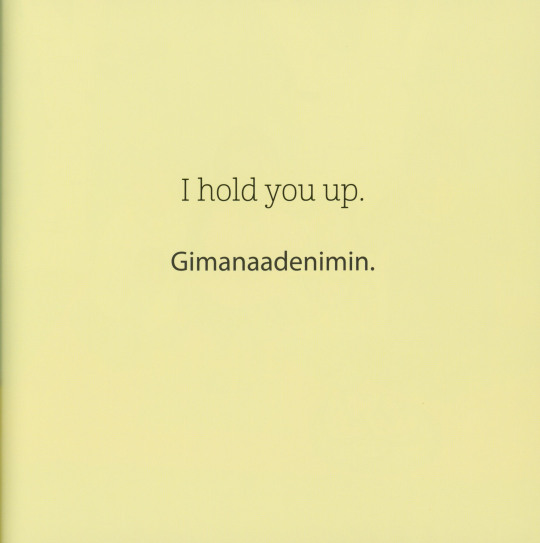


Happy World Kindness Day! Observed annually on November 13th, World Kindness Day encourages us to set aside our differences and focus on recognizing and participating in good deeds and kindness throughout our communities. In recognition of the day, we are sharing You Hold Me Up Gimanaadenim written in English by Cree author Monique Gray Smith with illustrations by Canadian First Nations author and artist Danielle Daniel, and translated to Anishinaabemowin by two UW-Milwaukee-associated Ojibwe-language specialists Angela Mesic and Margaret Noodin.
While You Hold Me Up Gimanaadenim was written to inspire children to show each other love and support, the lessons are applicable at any stage in life. Gray Smith writes that the book was written in the “spirit of Reconciliation”, coupled with Daniel’s vibrant illustrations it successfully demonstrates how to be more empathetic and build loving relationships.
You Hold Me Up was published in English in 2017 and met with many accolades including the 2017 American Indians in Children’s Literature Best Books award and 2018 Global Read Aloud award. It went on to be translated to Anishinaabemowin in 2021. Both versions were published by Orca Book Publishers out of British Columbia who notes that the translation “has been done according to more western conventions used by speakers of Anishinaabemowin. . . and matches the lexicon found in the Ojibwe People’s Dictionary.”

View other Milestone Monday posts.
– Jenna, Special Collections Graduate Intern
#world kindness day#you hold me up#gimanaadenim#monique gray smith#danielle daniel#angela mesic#margaret noodin#anishinaabemowin#orca book publishers
44 notes
·
View notes
Text
Remember Your Asemaa
There was once a boy. He lived by a creek with his grandmother. In the early evenings, he would go out before the sun set to look for things.
His grandmother had a gift. She was a maker, and she always transformed anything he brought home to her into something magical.
His grandmother taught him from very young the importance of laying your asemaa down as an offering, to say miigwetch for what you are taking from the land.
One time, the boy went out looking, offered his tobacco, and brought home a big partridge miigwan. He gave the feather to ookomisan, and she made a beautiful dreamcatcher to hang above his bed by the window.
Another time, he found a nice birch tree. He put down some asemaa and began peeling the bark. When he got home, his grandmother spent the whole weekend weaving a strong basket so they could pick more miinan.
This time, though, the boy went out and found a short, smooth piece of driftwood. As he was examining it, something else down by the water caught his eye. A small, rounded rock with a hole in the center. The boy, now excited, took the piece of wood and the rock back with him in a hurry as the sun was beginning to set.
The next morning, his grandmother admired the piece of wood he brought back before deciding what it would become. She began working and the boy sat in the corner playing with the small rock he found. He looked up, and saw a transformation take place before his very eyes. His grandmother tossed the whittled bits from her lap into the fireplace and came over to the boy with mitigo-jiimaan. He took it from her and they headed outside to the creek to test it out.

He placed it down onto the water. It worked! It could float! The boy jumped up and hugged his grandmother to thank her. The boy stayed outside awhile to play with his little wooden canoe.
The next morning, the boy's grandmother was upset. She explained that when she woke up she found the small canoe she had worked so hard making had been broken in half.
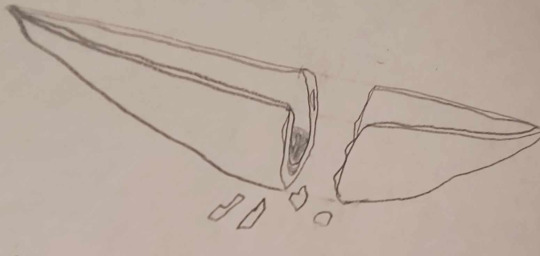
The boy begged his grandmother to believe that he would never break it. She thought for a moment, and asked him to calmly explain what happened the day before. When he was done, his grandmother instantly knew what had gone wrong. He had forgotten to offer tobacco. She sent the boy out with some asemaa in one half of the broken canoe, and some maple taffy in the other to offer up to memegwesiwag. She told him that the little people would accept his apology if he made sure to always offer his tobacco.
Early the next morning, the boy went to grab his special rock to take with him to go see what had happened to his canoe down by the creek. It was gone! The boy raced down to the water, hoping for some good news. His canoe wasn't there anymore, either!
The boy ran back home to his grandmother and started crying. She hugged him and told him to calm down, and that she would make him some cedar tea. The boy went to his corner by the fireplace, and couldn't believe his eyes. There was his now-fixed mitigo-jiimaan, complete with tiny, ornate carvings along where the crack had been. Inside the canoe, he found his rock turned into a necklace. His grandmother told him that he should wear it every day, to remind him to always remember his asemaa.

Chi-miigwech for reading and sharing my story.
asemaa: tobacco
miigwetch: thank you
miigwan: feather
ookomisan: [his] grandmother
miinan: blueberries
memegwesiwag: little people (dwarf spirits)
mitigo-jiimaan: wooden canoe
#writblr#indigenous#indigenous heritage#native#indigenous stories#short stories#métis#anishinaabe#anishinaabemowin#ndn#indigenous writers
25 notes
·
View notes
Text
Anishinaabedog! Ganawaabandamok oshki-mazina’igan enishinaabewibii’igaadeg! Gigashkitoon noondaman gakina omaa Ojibwe People’s Dictionary, adaawen o’ow mazina’igan ji-agindaman.
Check out this new book and collection of audio in Ojibwe! You can listen to the stories free at the link above, or buy the book to get the stories in English and Ojibwe.

13 notes
·
View notes
Text

Biitooshin asin. - “The rock lays in layers.”
Biitooshin vai. it (animate) lays in layers
Asin na. rock
10 notes
·
View notes
Text
“I struggled through school, being spoon-fed out of a bucket of whiteness every day,” he reflects.
“I found ambition, pursued a formal education after high school and beyond but I knew I was just buying time and building credentials. I was subversive, contrarian, driven, and ready to do something big and bold. I wanted to turn the whole education system of torture on its head. I just needed to find a way.”
51 notes
·
View notes
Text

Nanabozho transforming!
17 notes
·
View notes
Text
something i love
how we speak about the concept of 'History' in my area is "Nbisiing Mii yi edebwetmaang" which means 'This is what we believe'
7 notes
·
View notes
Text

credit - unknown
#indigenous#anishinaabe#métis#mixed#native#indigenous heritage#anishinaabemowin#ndn#indigenous art#indigenous stories#resilience#indigenous resistance#two spirit
4 notes
·
View notes